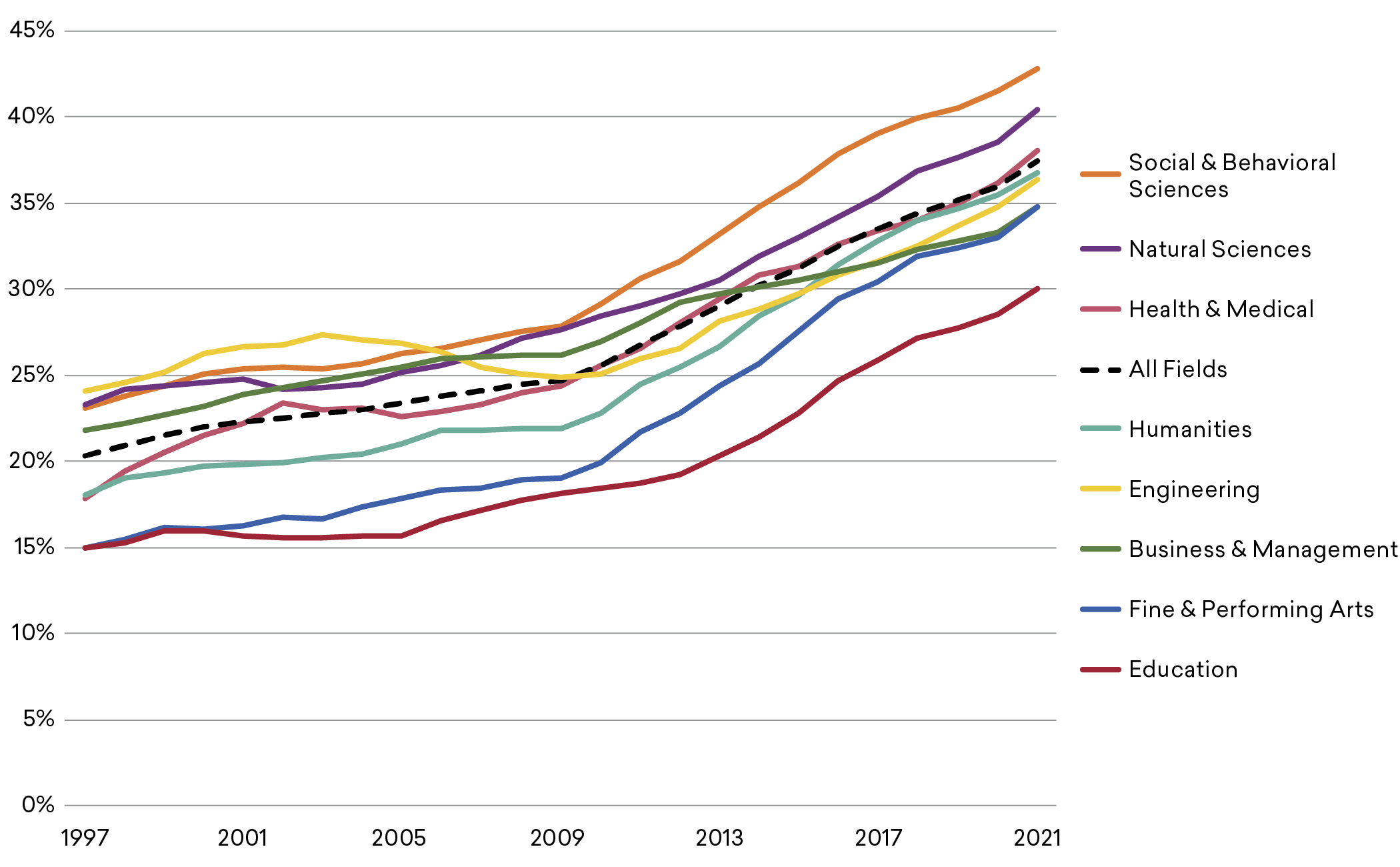By Robert B. Townsend, Codirector of the Humanities Indicators and Program Director for Humanities, Arts, and Culture at the Academy
Despite the many challenges to higher education during the COVID-19 pandemic, the number of bachelor’s degrees awarded by every field except the humanities increased through the end of the 2021 academic year. According to a new analysis of federal data by the Academy’s Humanities Indicators project, the total number of bachelor’s degrees conferred increased by 2.6 percent from 2019 to 2021, with the largest increases found in both engineering and the health and medical sciences (each increasing by 6.7 percent; see Figure 1). For additional information on the disciplinary categories assigned in each discipline, visit the Humanities Indicators project.
The only field awarding a smaller number of bachelor’s degrees in 2021 was the humanities, as the number of new graduates fell by 4.4 percent after 2019. Unfortunately for those in the field, the decline is part of a larger pattern that extends back a decade. Since 2012, the annual number of baccalaureate degrees fell by 18.3 percent (from 236,826 degrees in 2012 to 193,487 in 2021). Two other fields also experienced declines after 2012: the number of bachelor’s degrees in education decreased by 10.5 percent in 2021, and the number of graduates in the fine and performing arts declined by 6.0 percent. However, both fields have reported modest increases in 2020 and 2021.
Figure 1. Bachelor’s Degree Completions, by Field, 1997–2021

Source: U.S. Department of Education, Integrated Postsecondary Data System. Data analyzed and presented by the American Academy of Arts and Sciences’ Humanities Indicators.
The same data tabulations from the Humanities Indicators served as the basis for a recent article in The New Yorker with the apocalyptic title “The End of the English Major.”1 Somewhat lost in the label is evidence that almost every discipline in the humanities has been declining since 2012. The number of graduates in history, religious studies, archaeology, and area studies fell by one-third or more over that nine-year span, and degrees in languages and literatures other than English decreased by 31 percent.
What the data cannot answer is why the number of bachelor’s degrees in most fields continued to rise through the pandemic, while the humanities continued to fall. The New Yorker article points to latent job fears among potential humanities majors (despite recent findings from the Humanities Indicators showing that humanities graduates are similar to other college graduates in their levels of unemployment, earnings, and job satisfaction). The article also lays blame on other structural and cultural changes, such as the decline in long-form reading and shifts in general education course requirements, though the data to validate those causes remain indirect.
For higher education as a whole, there is good news in the demographics of the students earning degrees. The representation of students from traditionally minoritized racial and ethnic groups increased throughout the pandemic, rising to 37.5 percent of the graduates in 2021 – the largest share on record, though still lower than the representation in the population of young Americans. This assessment relies on the categories deployed and collected by the U.S. Department of Education, and includes Hispanic or Latino (any race), American Indian or Alaska Native, Asian, Black or African American, Native Hawaiian or Other Pacific Islander, and Two or More Races.
Figure 2. Percentage of Bachelor’s Degrees Awarded to Members of Traditionally Underrepresented Racial/Ethnic Groups, 1997–2021

Source: U.S. Department of Education, Integrated Postsecondary Data System. Data analyzed and presented by the American Academy of Arts and Sciences’ Humanities Indicators.
Nevertheless, the increase in representation reflects growth of more than 12 percentage points in every field since 1997, and the share is more than doubled among those earning bachelor’s degrees in education, the fine and performing arts, the health and medical sciences, as well as the humanities. Much of the recent growth is due to a sharp increase in the number of Hispanic/Latino students.
The share of women earning degrees (again relying on the gender binary categories collected by the U.S. Department of Education) also rose to the highest level on record in 2021, with women accounting for 58.4 percent of the bachelor’s degrees conferred – significantly higher than their share in the college-age population. As of 2021, women represented a 58 percent or greater share of the students earning degrees in every field except business (in which they accounted for 46.8 percent of the degree recipients) and engineering (just 23.2 percent).
What lies ahead remains a question, not just for the humanities but for the academy at large. Reported degree awards are a lagging indicator, showing two years after the fact how many students who had started their studies four or more years ago completed their degrees. It does not reflect how many students dropped out because of the challenges and pedagogical changes of the pandemic. It also does not tell us how many students who started in 2019 and 2020 have had their college studies hobbled by the challenges they experienced due to the closure of their high schools during the pandemic. (In a series of focus groups with department chairs in March 2023, the Humanities Indicators staff heard frequent laments about the effects of learning loss on recent admissions into their programs.) And separate studies from the National Student Clearinghouse show a substantial decline in the number of students in college (with community colleges particularly hard hit). Given all those troubling signs, the Humanities Indicators staff will be watching these trends closely, and reporting on them again in the future.
For questions about this report or any other aspects of the work of the Humanities Indicators, please contact the codirector of the project, Robert Townsend, at rtownsend@amacad.org. For more information about the Humanities Indicators, visit the Academy’s website.
